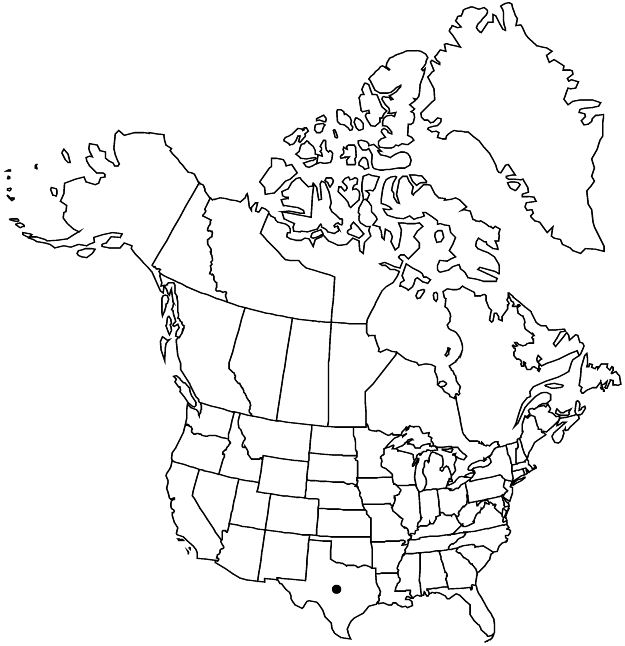Difference between revisions of "Prunus havardii"
J. Agric. Res. 1: 153, 176. 1913.
FNA>Volume Importer |
imported>Volume Importer |
||
| (6 intermediate revisions by 2 users not shown) | |||
| Line 8: | Line 8: | ||
}} | }} | ||
|common_names=Havard’s almond | |common_names=Havard’s almond | ||
| − | |basionyms={{Treatment/ID/ | + | |basionyms={{Treatment/ID/Basionym |
|name=Amygdalus havardii | |name=Amygdalus havardii | ||
|authority=W. Wight | |authority=W. Wight | ||
| + | |rank=species | ||
| + | |publication_title=in W. R. Dudley et al., Dudley Mem. Vol., | ||
| + | |publication_place=133. 1913 (as harvardii) | ||
}} | }} | ||
|synonyms= | |synonyms= | ||
| Line 27: | Line 30: | ||
|elevation=700–1700 m | |elevation=700–1700 m | ||
|distribution=Tex.;Mexico (Chihuahua). | |distribution=Tex.;Mexico (Chihuahua). | ||
| − | |discussion=<p>Prunus havardii is endemic to the Chihuahuan Desert of trans-Pecos Texas and across the Rio Grande in Mexico, with most collections from the Big Bend area.</p> | + | |discussion=<p><i>Prunus havardii</i> is endemic to the Chihuahuan Desert of trans-Pecos Texas and across the Rio Grande in Mexico, with most collections from the Big Bend area.</p> |
|tables= | |tables= | ||
|references= | |references= | ||
| Line 36: | Line 39: | ||
-->{{#Taxon: | -->{{#Taxon: | ||
name=Prunus havardii | name=Prunus havardii | ||
| − | |||
|authority=(W. Wight) S. C. Mason | |authority=(W. Wight) S. C. Mason | ||
|rank=species | |rank=species | ||
| Line 51: | Line 53: | ||
|publication year=1913 | |publication year=1913 | ||
|special status= | |special status= | ||
| − | |source xml=https:// | + | |source xml=https://bitbucket.org/aafc-mbb/fna-data-curation/src/2e0870ddd59836b60bcf96646a41e87ea5a5943a/coarse_grained_fna_xml/V9/V9_609.xml |
|subfamily=Rosaceae subfam. Amygdaloideae | |subfamily=Rosaceae subfam. Amygdaloideae | ||
|tribe=Rosaceae tribe Amygdaleae | |tribe=Rosaceae tribe Amygdaleae | ||
Latest revision as of 22:58, 5 November 2020
Shrubs, suckering unknown, much branched, 10–20 dm, thorny. Twigs with axillary end buds, puberulent. Leaves deciduous; petiole 1–3 mm, glabrous or puberulent, eglandular; blade rhombic, obovate, or fan-shaped, 0.5–1.6(–2) × 0.2–0.8(–1.4) cm, base broadly obtuse or rounded to nearly truncate, margins serrate or dentate in distal 1/2, teeth blunt to sharp, some callus-tipped, rarely glandular, apex rounded to obtuse, surfaces puberulent. Inflorescences solitary flowers. Pedicels 0 mm. Flowers unisexual, plants dioecious, blooming at leaf emergence; hypanthium campanulate, 2.5–3 mm, glabrous externally; sepals spreading to reflexed, triangular, 0.7–1 mm, margins entire, sparsely ciliate, surfaces glabrate; petals white, obovate, 2 mm; ovaries hairy. Drupes reddish brown, ovoid, 8–11 mm, puberulent; hypanthium tardily deciduous; mesocarps leathery to dry (splitting); stones ovoid, slightly flattened.
Phenology: Flowering Apr–Jun; fruiting Jun–Aug.
Habitat: Draws, dry rocky slopes of canyons, limestone soil, igneous rock
Elevation: 700–1700 m
Distribution

Tex., Mexico (Chihuahua).
Discussion
Prunus havardii is endemic to the Chihuahuan Desert of trans-Pecos Texas and across the Rio Grande in Mexico, with most collections from the Big Bend area.
Selected References
None.